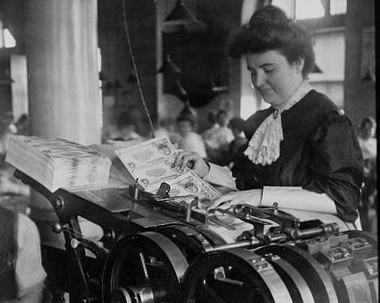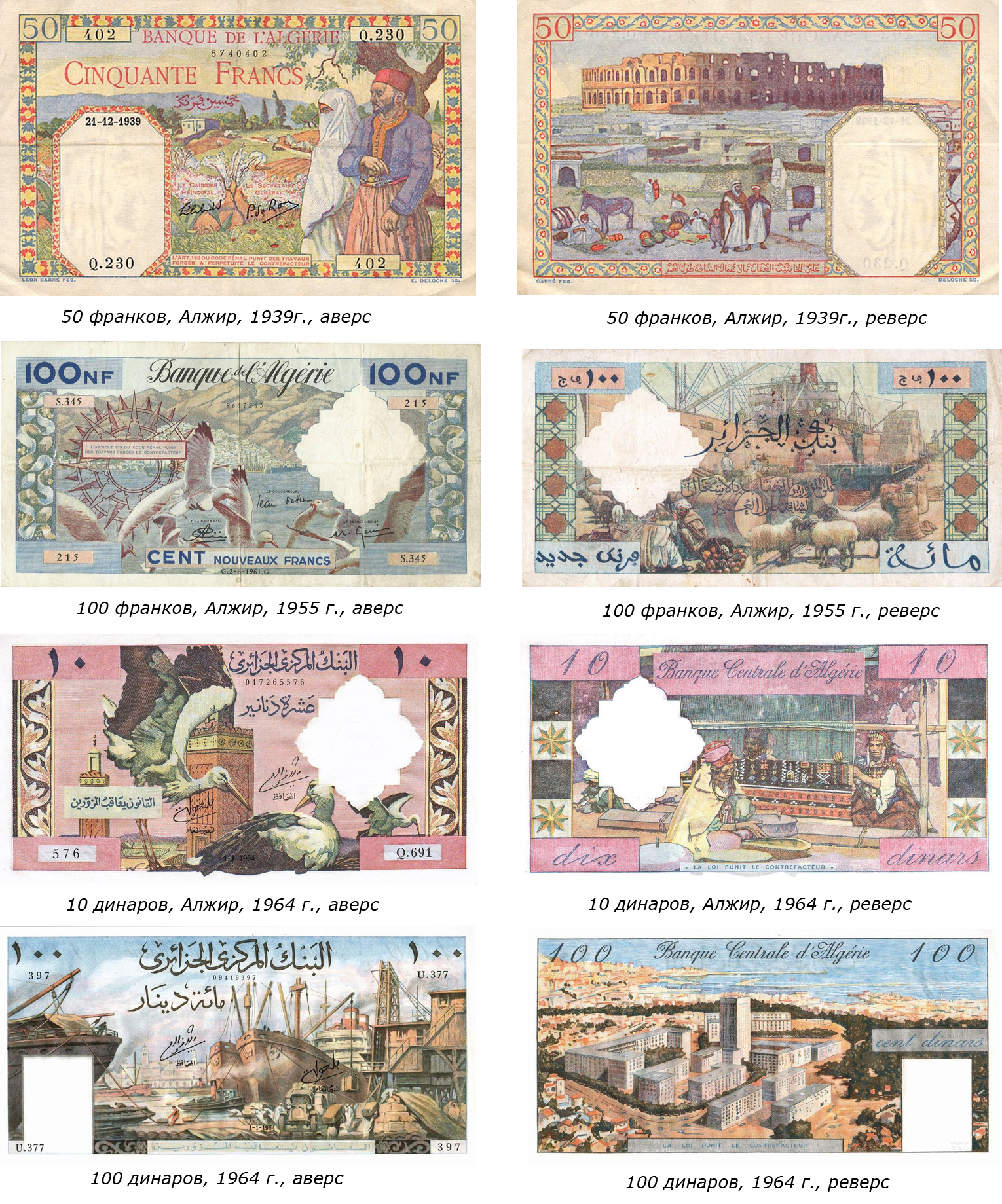Money of the XX century: a selection of bills, out of circulation
 Hi, Geektimes! In the continuation of a series of articles on fiat money from different parts of the world, today we are publishing a new review that contains banknotes issued in the 20th century and which have already come out of circulation. This material is not a rating, the choice of currencies is based on the subjective assessment of the editors of PayOnline , the international system for accepting online payments.
Hi, Geektimes! In the continuation of a series of articles on fiat money from different parts of the world, today we are publishing a new review that contains banknotes issued in the 20th century and which have already come out of circulation. This material is not a rating, the choice of currencies is based on the subjective assessment of the editors of PayOnline , the international system for accepting online payments.French franc
The franc got its name in honor of the liberation of King John the Second from captivity during the Hundred Years War (from the French "franc" - "free").
The very first franc was minted in France in 1360 and had the form of a golden coin. Since then, as a result of numerous reforms, the French monetary unit has been constantly transformed. At the end of the 18th century, the first paper notes and banknotes appeared in the country — a forced measure designed to overcome a cash deficit. At the beginning of the XX century there was a complete rejection of gold and silver coins.
')
Issue 1. How did world currencies get their names?
Issue 2. Rating of the most beautiful money of the world
Issue 3. Composite coins - an alternative to paper and metal
Release 4. Money of the XX century: a selection of bills, out of circulation
The period from 1914 to 1959. in the history of the French franc characterized by multiple and significant devaluations and high inflation. In this regard, all new banknotes were introduced into circulation - of different denominations, sizes and appearance. Here are just a few of the notes issued in the 20th century:
The key element of the design of French banknotes (both obverse and reverse) throughout the XX century remained invariably portraits of prominent figures of science, culture, politics, as well as historical subjects and characters. In 2002, the euro came to replace the franc.
Algerian Dinar
The Algerian dinar was put into circulation in 1964 after Algeria gained independence from France and was replaced by the Algerian franc, which had been in the country since the middle of the 19th century. Also, before the introduction of the dinar in the country often used the currency of other countries.

The first Algerian dinars differed a large format, bright colors, as well as interesting images, but they were very shabby and quickly wore out, like many other currencies of Arab countries. The size of banknotes varied depending on the nominal value - from 160 x 82 mm for 5 dinars to 220 x 112 mm for 100 dinars. Currently, the smallest in denomination is the bill of 100 dinars, and although the gradation in size has been preserved, the new type of banknotes have been significantly “trimmed”. For comparison, now the denomination of 1000 dinar (the largest) has a format of 160 × 72 mm.
The obverse of the 10 dinar bill of 1964 depicts a pair of storks in the background of the minarets of the Sidi Boumeddin mosques and the Great Mosque. Storks are a symbol of peace. On the reverse of the bill, women are depicted at work — one of them sifts flour for cake, the others weave a national carpet. The fourth, according to some version, something goes through or washes.
Japanese yen
The Japanese yen is one of the most stable and protected world currencies. As the main unit, the yen was officially adopted in 1871 after the reform of the “new” government, designed to simplify the country's monetary system. Prior to that, there were at the same time paper, gold, silver and copper coins, which were also issued not only by the central government, but also by individual principalities, which greatly complicated the mutual settlements in the country.
After the reform, only the yen remained in the turnover, the seni are the hundredth part of the yen, and the rins are the tenth part of the sen. In 1946, the government decided to issue new banknotes in denominations of 100, 10, 5 and 1 yen. Later, in 1950, a new banknote in denominations of 1000 yen was put into circulation, in 1957, 5,000 yen, in 1958, a banknote of 10,000 yen, which is still the largest in parity. Some paper bills eventually transformed into metallic money: in 1948, this happened with bills of 1 and 5 yen, in 1950 - from 10, in 1957 - from 100, and in 1982 - with 500 yen.
Czechoslovak Crown
The Czechoslovak krone was put into circulation in 1919 instead of the Austro-Hungarian krone by affixing signs of conformity on the notes of the Austro-Hungarian Bank. Gradually, these banknotes were replaced with new ones, issued since 1919 by the Banking Department of the Ministry of Finance, and after 1926 with banknotes of the National Bank of Czechoslovakia.
On the bills of 1919-1939, the face value in words was denoted not only in Czech and Slovak, but also in German, Hungarian and Russian. After the collapse of Czechoslovakia in 1993 in the Czech Republic, the currency was replaced by the Czech krona, in Slovakia - by the Slovak.
On the obverse side of the 1,000-kronor note in 1934 is a woman reading a book to children, on the back side is a portrait of a Czech historian, head of the historical department of the National Museum and a politician, Frantisek Palacky.
On the obverse of the banknote of 20 kroons in 1988 there is a portrait of a Czech teacher, writer, founder of scientific pedagogy - Jan Amos Komensky. On the reverse there is a symbolic image of the tree of knowledge and the fruits that the teaching gives, as well as a man and a woman with a book in their hands.
Frank Djibouti
The Republic of Djibouti is a state located in East Africa in the region of the Somali Peninsula. Currently in circulation are banknotes with nominal values of 1000, 2000, 5000 and 10,000 francs of Djibouti type of 1997, which are not very elegant. But bills issued in the first half of the last century have a rather attractive design:
On the front side of the bill of 10,000 francs of Djibouti sample of 1984 is a portrait of a woman with a child, in the background is a tree with goats and a cowgirl. On the reverse side of the banknote is a portrayal from a bird's-eye view.
The image of goats on a tree on the obverse of a bill is not an artist’s fantasy. On the African continent, such a phenomenon is not uncommon. Due to the lack of pastures, goats are forced to “graze” in the trees. Balancing on the branches helps them innate ability to keep balance in the most unstable places. So it looks like in life:

Norwegian Krone
The Norwegian krone is one of the oldest currencies in the world. Own money appeared on the territory of Scandinavia more than 1000 years ago, the first banknotes appeared in Norway in 1695 - earlier than in most European countries.
From the beginning of the 20th century and up to the 50s, the appearance of bills changed only slightly, just as the Norwegian government did not change - from 1905 until his death in 1957, the country was reigned by King Haakon VII. Norway did not take an active part in World War I, the crisis of the 1930s, which broke out in Europe and North America, affected the country's economy, but the situation was not as severe as in most other countries. There was no need for a currency denomination, nor was there any need to change the design of banknotes in the government.
However, by the middle of the century, the appearance of bills was very outdated and no longer met modern protection requirements. Approximately in 1955, the Bank of Norway issued banknotes of a new type, portraits of political figures appeared on the obverse, and on the reverse side - famous sights, historical subjects, cultural monuments. The next cardinal change in the design of banknotes occurred in the 70s.
Maltese Lira (pound)
Maltese Lira lasted 59 years. For the first time in the Maltese money market, the lira appeared in 1949 and remained the national currency until 2008, when it was replaced by the euro. Until 1949, the Maltese and British pounds were in circulation.
The issue of its own currency in Malta was due to a shortage of pounds sterling (in 1800 the island became British ownership, in 1855 pound sterling was declared the only official means of payment). Own banknotes - Maltese pounds - appeared on the island in 1914, but a year later Maltese paper pounds were replaced by British ones. In 1939, communication with the Bank of England was lost, and the Government of Malta again issued its own notes. In 1949, Malta passed a law on the introduction of its own national currency - the Maltese pound, which in 1983 was renamed the lira - and the withdrawal of British banknotes from circulation. It is noteworthy that the Central Bank of Malta was established only in 1967.
Next, we present you a few bills issued in different years of the XX century in different countries of the world:
All images are taken from open sources. Continue to follow PayOnline International Processing Company blog updates . There are still a lot of interesting posts about the global payment industry, financial technologies and the history of the industry.
Source: https://habr.com/ru/post/369685/
All Articles